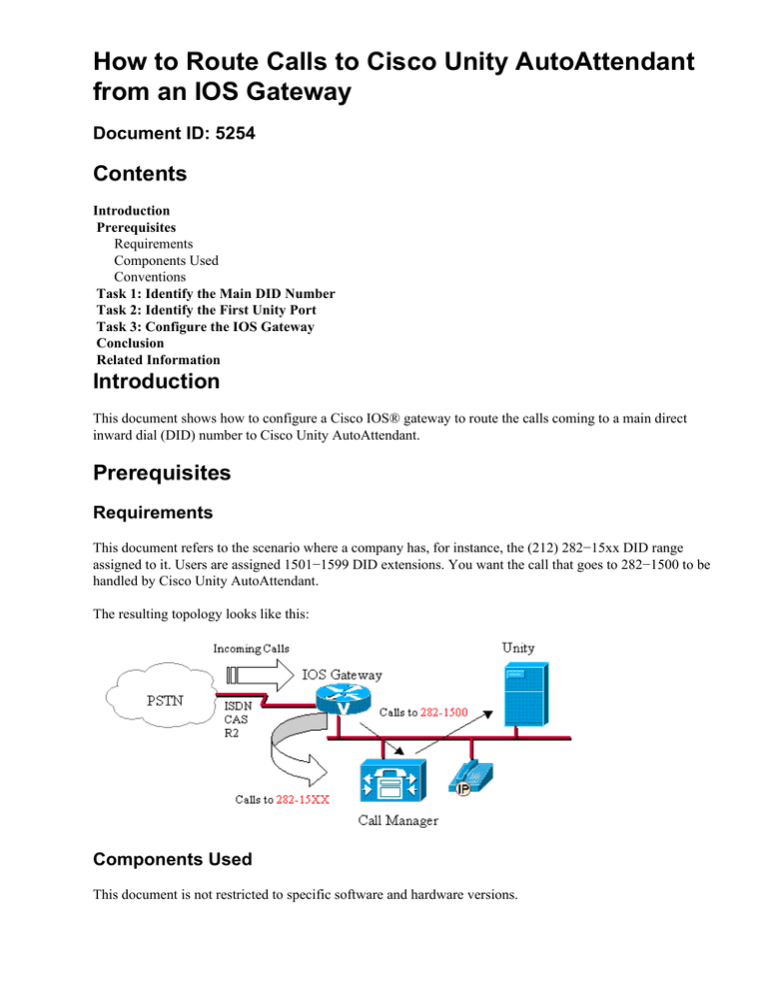
How to Route Calls to Cisco Unity AutoAttendant
from an IOS Gateway
Document ID: 5254
Contents
Introduction
Prerequisites
Requirements
Components Used
Conventions
Task 1: Identify the Main DID Number
Task 2: Identify the First Unity Port
Task 3: Configure the IOS Gateway
Conclusion
Related Information
Introduction
This document shows how to configure a Cisco IOS® gateway to route the calls coming to a main direct
inward dial (DID) number to Cisco Unity AutoAttendant.
Prerequisites
Requirements
This document refers to the scenario where a company has, for instance, the (212) 282−15xx DID range
assigned to it. Users are assigned 1501−1599 DID extensions. You want the call that goes to 282−1500 to be
handled by Cisco Unity AutoAttendant.
The resulting topology looks like this:
Components Used
This document is not restricted to specific software and hardware versions.
Conventions
Refer to Cisco Technical Tips Conventions for more information on document conventions.
Task 1: Identify the Main DID Number
It is very important to know the exact main DID number as it is presented by the PSTN to correctly route the
call.
In order to check it, enable the q931 debugs for the ISDN connection to the PSTN and make a test call to the
main DID number.
Refer to Important Information on Debug Commands before you issue debug commands.
coldcut#debug isdn q931
ISDN Q931 packets debugging is on
coldcut#
00:09:09: ISDN Se1/0:15: RX <− SETUP pd = 8 callref = 0x0004
00:09:09:
Bearer Capability i = 0x8090A3
00:09:09:
Channel ID i = 0xA9839F
00:09:09:
Progress Ind i = 0x8083 − Origination address is non−ISDN
00:09:09:
Calling Party Number i = 0x0080, '27042004', Plan:Unknown, Type:Unknown
00:09:09:
Called Party Number i = 0x80, '2821500', Plan:Unknown, Type:Unknown
00:09:09: ISDN Se1/0:15: TX −> CALL_PROC pd = 8 callref = 0x8004
00:09:09:
Channel ID i = 0xA9839F
....
The calling number for the main DID is presented as 2821500.
Task 2: Identify the First Unity Port
Complete these steps in order to identify the first Cisco Unity port:
1. Go to the Cisco CallManager Administration page and choose Cisco Voice Mail Port from the
Device Menu.
2. Click the first port on the left pane.
Task 3: Configure the IOS Gateway
Use this configuration on the Cisco IOS gateway.
num−exp 2821500 1000
!−−− This converts the called 2821500 to 1000.
dial−peer voice 1000 voip
destination−pattern 1000
dtmf−relay h245−alphanumeric
!−−− This command must be configured to relay the dialed digits.
session target ipv4:10.200.72.36
codec g711ulaw
!−−− This dial peer tells the Cisco IOS gateway where to route the
!−−− calls for extension 1000.
!−−− In this case, it sends the call to Cisco CallManager (10.200.72.36).
Note: A similar IOS configuration can be used to a route call to the Auto Attendant (AA) in Cisco Unity
Express when used with Cisco CallManager Express. Refer to Cisco CME Basic Automatic Call Distribution
for more information.
Conclusion
The resulting behavior is:
• When Cisco Unity receives the call, it plays the Opening Greeting, as the calling number is not a
subscriber in Unity.
• If you want to log into your mailbox, you can press the * key during the Opening Greeting
announcement and enter your mailbox ID and password.
• If you want to dial an extension during the Opening Greeting, you can only enter an extension that is
configured as a subscriber or a Call Handler in the Cisco Unity system. IP phones, CTI ports, route
points, and pilot points that are not configured as Cisco Unity subscribers or call handlers cannot be
reached.
• Call transfer only occurs if the subscriber's Call Transfer option is set to "Yes, ring subscriber's
extension" or "Yes, ring subscriber at this number." Otherwise, the caller is sent to the user's voice
mailbox.
Related Information
• Voice Technology Support
• Voice and Unified Communications Product Support
• Troubleshooting Cisco IP Telephony
• Technical Support & Documentation − Cisco Systems
Contacts & Feedback | Help | Site Map
© 2014 − 2015 Cisco Systems, Inc. All rights reserved. Terms & Conditions | Privacy Statement | Cookie Policy | Trademarks of
Cisco Systems, Inc.
Updated: Oct 27, 2006
Document ID: 5254


